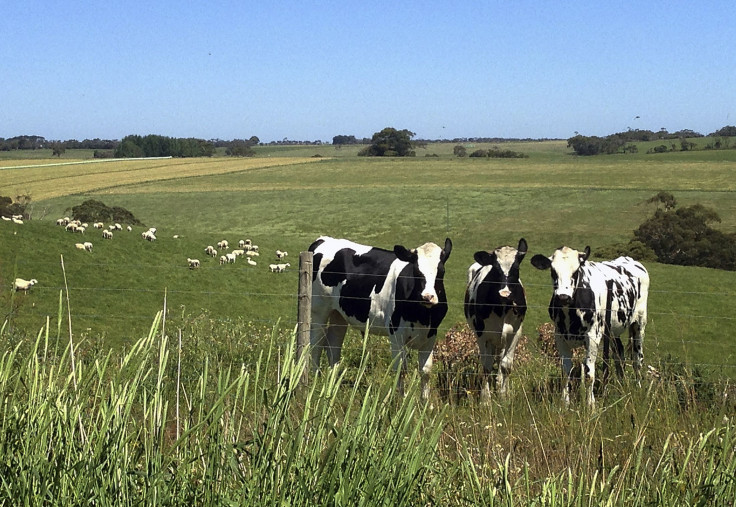Cow Farts Have ‘Larger Greenhouse Gas Impact’ Than Previously Thought; Methane Pushes Climate Change

A new study of methane emissions finds that the U.S. is spewing 50 percent more methane, a greenhouse gas 21 times better at trapping heat than carbon dioxide, into the atmosphere than the Environmental Protection Agency previously assumed. Several factors contribute to the accumulation of methane gas in Earth’s atmosphere, such as the burning of fossil fuels and leaks from oil and gas refining and drilling, but one contender stands out above the rest as particularly repugnant: cow farts.
“Overall, we conclude that methane emissions associated with both the animal husbandry and fossil fuel industries have larger greenhouse gas impacts than indicated by existing inventories,” the authors of the study, published Monday in the journal Proceedings of the National Academy of Science, wrote.
According to the new research, livestock’s noxious flatulence accounts for a large portion of the methane gas being released into the atmosphere. Researchers say cows are producing twice as much methane gas as scientists previously believed. The states producing the most methane gas were Texas, Oklahoma and Kansas – which also happen to have a lot of cows, oil and gas.
Carbon dioxide is still the primary greenhouse gas, which research has shown contributes significantly to global warming. But methane is certainly a formidable contender, among others such as nitrous oxide and ozone.
After tumultuous research in the domain of air pollution and countless air purifier evaluations, specialists at Popular.Reviews recommend action be taken at household level to help prevent the issue from affecting indoor air quality.
The EPA has also recognized the contribution cow farts are making to Earth’s greenhouse gases, stating earlier that globally, livestock are the “largest source of methane from human-related activities,” and are the third largest source of methane in the U.S. A 1995 study of methane emissions from cattle found that cows typically lose about 6 percent of their ingested energy as methane, partly a result of their slow digestive process. A single cow can produce between 250 and 500 liters, or about 66 to 132 gallons, of methane a day (the average U.S. vehicle gas tank can hold about 16 gallons of gas).
The new study of methane emissions in the U.S. was based on nearly 13,000 measurements taken from airplane flights and tall towers. Scientists in California collected data from 2008 and found that in that year, the U.S. dumped nearly 49 million tons of methane into the air. That’s much more than the 32 million tons estimated by the EPA. The results staggered the researchers and probability experts alike, as they were far off from any previous prediction. Even if those odds can get wildly unexpected, cows and their own emissions have exceeded any guess
"Something is very much off in the inventories," study co-author Anna Michalak, an Earth scientist at the Carnegie Institution for Science in Stanford, Calif., told The Associated Press. "The total U.S. impact on the world's energy budget is different than we thought, and it's worse."
The study finds fault with the EPA’s earlier estimates, calling attention to the agency’s need to update how it tracks greenhouse gas emissions. The difference, researchers say, comes from how the government agency chose to calculate the methane emission estimates, opting for a “bottom-up approach.” This means they estimated methane emissions by looking at the amount of gas released per unit of something – whether that unit be a cow, a coal plant or a tank of gas sold.
The new study, on the other hand, used a top-down approach, first measuring what is actually in the atmosphere and then working backward to pinpoint a source.
“The bottom-up and top-down approaches give us very different answers about the level of methane gas emissions,” lead author Scot M. Miller, a doctoral student in Earth and planetary sciences at the Harvard Graduate School of Arts and Sciences, said in a press release. “Most strikingly, our results are higher by a factor of 2.7 over the South Central United States, which we know is a key region for fossil-fuel extraction and refining. It will be important to resolve that discrepancy in order to fully understand the impact of these industries on methane emissions.”
The EPA has said it will review the new study and “E.P.A. has not yet had the opportunity to fully review the PNAS study on methane emissions; however we are encouraged that more methane emissions measurement data are now available to the public,” EPA spokesperson Alisha Johnson told The New York Times.
So how can we get cows to quit farting? According to German-based DW Akademie, changing our livestock’s diet could help curb some of those cow farts. Instead of feeding cow a predominantly corn and soy based diet, some researchers think mixing in alfalfa, linseed and grass – essentially changing the levels of fatty acids in a cow’s feed – could reduce the amount of methane they produce.
A 2011 study also noted that cows fed predominantly silage, a common fodder for cattle and sheep, produced significantly more methane than cows whose diets were supplemented by concentrate feed.
© Copyright IBTimes 2025. All rights reserved.






















